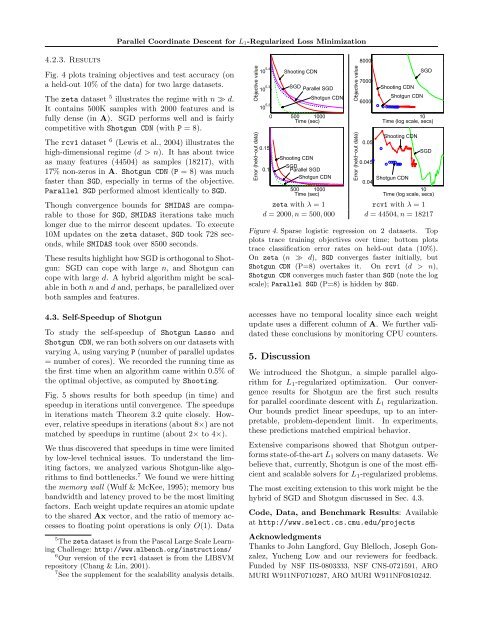Parallel Coordinate Descent for L1-Regularized Loss Minimization
Parallel Coordinate Descent for L1-Regularized Loss Minimization
Parallel Coordinate Descent for L1-Regularized Loss Minimization
Create successful ePaper yourself
Turn your PDF publications into a flip-book with our unique Google optimized e-Paper software.
<strong>Parallel</strong> <strong>Coordinate</strong> <strong>Descent</strong> <strong>for</strong> L 1-<strong>Regularized</strong> <strong>Loss</strong> <strong>Minimization</strong><br />
4.2.3. Results<br />
Fig. 4 plots training objectives and test accuracy (on<br />
a held-out 10% of the data) <strong>for</strong> two large datasets.<br />
The zeta dataset 5 illustrates the regime with n ≫ d.<br />
It contains 500K samples with 2000 features and is<br />
fully dense (in A). SGD per<strong>for</strong>ms well and is fairly<br />
competitive with Shotgun CDN (with P = 8).<br />
The rcv1 dataset 6 (Lewis et al., 2004) illustrates the<br />
high-dimensional regime (d > n). It has about twice<br />
as many features (44504) as samples (18217), with<br />
17% non-zeros in A. Shotgun CDN (P = 8) was much<br />
faster than SGD, especially in terms of the objective.<br />
<strong>Parallel</strong> SGD per<strong>for</strong>med almost identically to SGD.<br />
Though convergence bounds <strong>for</strong> SMIDAS are comparable<br />
to those <strong>for</strong> SGD, SMIDAS iterations take much<br />
longer due to the mirror descent updates. To execute<br />
10M updates on the zeta dataset, SGD took 728 seconds,<br />
while SMIDAS took over 8500 seconds.<br />
These results highlight how SGD is orthogonal to Shotgun:<br />
SGD can cope with large n, and Shotgun can<br />
cope with large d. A hybrid algorithm might be scalable<br />
in both n and d and, perhaps, be parallelized over<br />
both samples and features.<br />
4.3. Self-Speedup of Shotgun<br />
To study the self-speedup of Shotgun Lasso and<br />
Shotgun CDN, we ran both solvers on our datasets with<br />
varying λ, using varying P (number of parallel updates<br />
= number of cores). We recorded the running time as<br />
the first time when an algorithm came within 0.5% of<br />
the optimal objective, as computed by Shooting.<br />
Fig. 5 shows results <strong>for</strong> both speedup (in time) and<br />
speedup in iterations until convergence. The speedups<br />
in iterations match Theorem 3.2 quite closely. However,<br />
relative speedups in iterations (about 8×) are not<br />
matched by speedups in runtime (about 2× to 4×).<br />
We thus discovered that speedups in time were limited<br />
by low-level technical issues. To understand the limiting<br />
factors, we analyzed various Shotgun-like algorithms<br />
to find bottlenecks. 7 We found we were hitting<br />
the memory wall (Wulf & McKee, 1995); memory bus<br />
bandwidth and latency proved to be the most limiting<br />
factors. Each weight update requires an atomic update<br />
to the shared Ax vector, and the ratio of memory accesses<br />
to floating point operations is only O(1). Data<br />
5 The zeta dataset is from the Pascal Large Scale Learning<br />
Challenge: http://www.mlbench.org/instructions/<br />
6 Our version of the rcv1 dataset is from the LIBSVM<br />
repository (Chang & Lin, 2001).<br />
7 See the supplement <strong>for</strong> the scalability analysis details.<br />
Objective value<br />
Error (held−out data)<br />
10 5.4 Shooting CDN<br />
10 5.3 SGD <strong>Parallel</strong> SGD<br />
Shotgun CDN<br />
10 5.2<br />
0 500 1000<br />
Time (sec)<br />
0.15<br />
0.1<br />
Shooting CDN<br />
SGD <strong>Parallel</strong> SGD<br />
Shotgun CDN<br />
500 1000<br />
Time (sec)<br />
Objective value<br />
Error (held−out data)<br />
8000<br />
7000<br />
6000<br />
0.05<br />
0.045<br />
Shooting CDN<br />
Shotgun CDN<br />
SGD<br />
10<br />
Time (log scale, secs)<br />
Shooting CDN<br />
SGD<br />
Shotgun CDN<br />
0.04<br />
10<br />
Time (log scale, secs)<br />
zeta with λ = 1 rcv1 with λ = 1<br />
d = 2000, n = 500, 000 d = 44504, n = 18217<br />
Figure 4. Sparse logistic regression on 2 datasets. Top<br />
plots trace training objectives over time; bottom plots<br />
trace classification error rates on held-out data (10%).<br />
On zeta (n ≫ d), SGD converges faster initially, but<br />
Shotgun CDN (P=8) overtakes it. On rcv1 (d > n),<br />
Shotgun CDN converges much faster than SGD (note the log<br />
scale); <strong>Parallel</strong> SGD (P=8) is hidden by SGD.<br />
accesses have no temporal locality since each weight<br />
update uses a different column of A. We further validated<br />
these conclusions by monitoring CPU counters.<br />
5. Discussion<br />
We introduced the Shotgun, a simple parallel algorithm<br />
<strong>for</strong> L 1 -regularized optimization. Our convergence<br />
results <strong>for</strong> Shotgun are the first such results<br />
<strong>for</strong> parallel coordinate descent with L 1 regularization.<br />
Our bounds predict linear speedups, up to an interpretable,<br />
problem-dependent limit. In experiments,<br />
these predictions matched empirical behavior.<br />
Extensive comparisons showed that Shotgun outper<strong>for</strong>ms<br />
state-of-the-art L 1 solvers on many datasets. We<br />
believe that, currently, Shotgun is one of the most efficient<br />
and scalable solvers <strong>for</strong> L 1 -regularized problems.<br />
The most exciting extension to this work might be the<br />
hybrid of SGD and Shotgun discussed in Sec. 4.3.<br />
Code, Data, and Benchmark Results: Available<br />
at http://www.select.cs.cmu.edu/projects<br />
Acknowledgments<br />
Thanks to John Lang<strong>for</strong>d, Guy Blelloch, Joseph Gonzalez,<br />
Yucheng Low and our reviewers <strong>for</strong> feedback.<br />
Funded by NSF IIS-0803333, NSF CNS-0721591, ARO<br />
MURI W911NF0710287, ARO MURI W911NF0810242.



